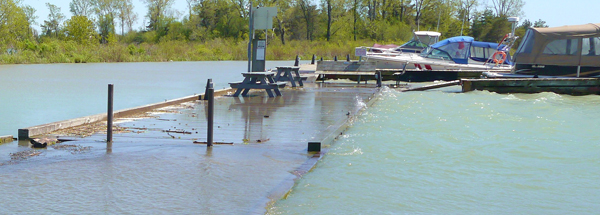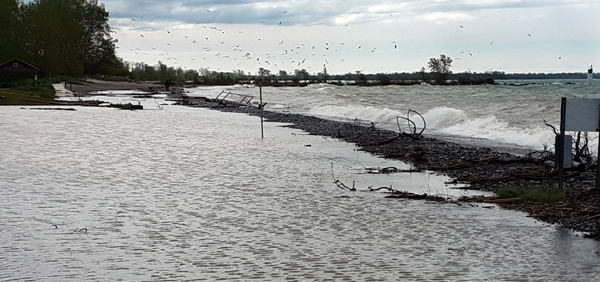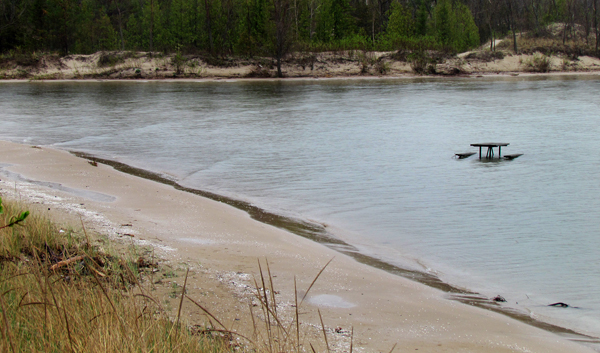Disappointment, but potential spark of hope in IJC response to politicians
Administrator | Oct 02, 2019 | Comments 7

The boat launch and docks at Wellington harbour were closed and under water as water levels continued to rise. Sharon Harrison photo
Quinte area municipal politicians have not received the answers they were hoping for from the International Joint Commission (IJC) concerning regulating water levels on Lake Ontario – but there could be a spark of hope in plans moving forward.
The politicians created a joint statement Sept 24, calling on the IJC (body that controls the water flows) to revoke the Lake Ontario – St. Lawrence River and reinstate Plan 1958.
They requested immediate action to reduce water levels and keep them down to fight “overwhelming damage to local infrastucture, public safety and health” along with “devasting impacts on tourism and economic development.”
The flooding, they stated is “a man-made problem, not a direct result of climate change” and stated the IJC is “refusing to take responsibility and needs to be held accountable.”
The IJC, in its letter to to the politicians, stated “no regulation plan can fully eliminate high water events on Lake Ontario or the St. Lawrence River system. This is the reality that we much all come to term with, and work together to mitigate future impacts on all affected shoreline communities.”
It also stated the IJC would have faced the same constraints if the old regulation plan had remained in place.
However, it did note the commission and board are investigating options to further reduce water levels ahead of spring 2020, including flows that could affect the commercial navigation season in the late fall, or early spring.
“We are also seeking the resources to perform an accelerated review of the performance of Plan 2014. This review would help identify what measures might help reduce flood risks both upstream and downstream.”
Further, it says it will use internal IJC funds to start projects that would support an accelerated review, including an economic assessment of the impact of high flows that would temporarily halt commercial navigation, a project to engage south shore municipalities in documenting high water impacts, and an assessment of issues related to low water and ice conditions on Lake St. Lawrence during winter operations.”

Wellington Beach has no beach, or roadway early June. – John Ferguson photo
Prince Edward County Mayor Steve Ferguson, had old the gathering of politicians the County is hardest hit in the region with 500kms of shoreline (Belleville 24kms and Quinte West 35kms), and added all the municipalities are concerned and fear they must prepare for even worse flooding in 2020.
Ferguson said as the County is preparing for more flooding in 2020, he wanted to see Plan 2014 revoked.

Sandbanks “dog” beach, and campers’ beach almost disappeared in 2017 flooding.
“Clearly, it’s not working. We experienced flooding in 2017 as a result of the implementation of this plan one year earlier. We experienced worse flooding this year, so it’s anybody’s guess what could happen next year, although we are preparing for, at least, similar circumstances.”
UPDATE: The IJC seeks citizen input on high water impacts (click here for more)
The full text of the IJC response letter to the heads of councils, below:
Thank you for your letter of September 25, 2019 concerning Great Lakes water levels.
We recognize that extremely high water conditions this year have caused tremendous harm to numerous communities along Lake Ontario and the St. Lawrence River.
When record high inflows to the lakes persist over many months, the ability of regulated outflows to influence Lake Ontario levels is greatly diminished. No regulation plan can fully eliminate high water events on Lake Ontario or the St. Lawrence River system.
This is the reality that we must all come to terms with and work together to mitigate future impacts on all affected shoreline communities.
During 2019, wet conditions across the entire Great Lakes region persisted for several months, resulting in record high inflows from Lake Erie into Lake Ontario, and record inflows from the Ottawa River into the lower St. Lawrence River. Water supplies to Lake Ontario in May 2019 surpassed the previous record high supplies of May 2017. The period from January to June 2019 was the six-month period with the highest water supplies to Lake Ontario on record.
The Commission’s International Lake Ontario-St. Lawrence River Board (the Board) regulates Lake Ontario outflows at the Moses-Saunders dam to reduce high-water impacts on the lake and river from Lake Ontario to the extent possible, while considering consequences for all affected interests.
The dam is the sole control point of outflows into the St. Lawrence River, and although it can be operated to manage many conditions, it cannot fully address all consequences of the record natural inflows experienced this year.
Outflows from June 13 to August 21 were the highest sustained outflows on record and continue to be as high as conditions on the St. Lawrence River allow. Lake Ontario continues to decline from its June 2019 peak.
Since Plan 2014 was implemented in January 2017, Lake Ontario maximum outflows have been determined by the following constraints more than 80 per cent of the time: balancing upstream and downstream flooding, preventing ice jams that could severely restrict outflows, avoiding dangerous conditions for navigation, and avoiding flows that would draw the river down below municipal water intakes. The Board would have faced these same constraints if the previous regulation plan had remained in place.
The IJC is committed to doing all it can to reduce the flood risk for next year, while taking into account all interests on Lake Ontario and the St. Lawrence River.
Currently, the Commission and the Board are investigating a number of options to further reduce water levels ahead of spring 2020, including flows that could affect the commercial navigation season in the late fall or early spring.
We are also seeking the resources to perform an accelerated review of the performance of Plan 2014. This review would help identify what measures might help reduce flood risks both upstream and downstream.
In the meantime, the Board will use internal IJC funds to start projects that would support an accelerated review, including an economic assessment of the impact of high flows that would temporarily halt commercial navigation, a project to engage south shore municipalities in documenting high water impacts, and an assessment of issues related to low water and ice conditions on Lake St. Lawrence during winter operations.
The Commission has made several visits to shoreline communities and met with some of the many affected elected officials on both sides of the boundary to hear their concerns firsthand.
The Commission has also committed to adding two new members municipal members to its Board so that communities on the lake and river are full participants in Board deliberations. Further to this, the Commission and its Board are organizing a webinar for elected officials in early November to explain 2019 conditions, the limits of regulation plans in such conditions and to answer questions and concerns that attendees might have. The date and time of the webinar will be posted to our website and social media pages shortly and we will ensure that you are informed directly.
Recognizing climatic variability and the likelihood of more extreme events in the future, the Commission also believes that it is prudent to work with all affected communities to help build more resiliencies in the floodplain so as to mitigate the impacts of future extreme floods.
Sincerely,
Jane Corwin and Pierre Béland
Chairs of the US and Canadian sections
Filed Under: Featured Articles
About the Author:
































Chris – you gave made very good points. Just to clarify my “tax dollar statement” – I am not critical of what was spent here in PEC, but rather it was about the general concern I have about more money going into the IJC, the challenges to their decision, etc.. without proper scientific investigation taking place first. Being a local taxpayer, I too appreciate the need for good roads and safe shorelines. I just want to see things done properly based on the science and not on the politics.
Dennis – several points. To date I believe the only tax dollars that have been spent in the County have been on sand bagging and road repairs as required.
However, County residents spent tens of thousands of dollars repairing/mitigating damage following the 2017 flooding only to have much of it destroyed this year. A second insurance claim is unlikely to be paid so they face more expenses this year. Homes on the south shore of Lake Ontario were particularly hard hit.
Since the new Plan 2014 was implemented there has been flooding in two of the past three years strongly suggesting this is not a coincidence. For this reason, affected residents and municipalities are asking the IJC to revert to the original plan from 1958 which allowed them to forecast and predict water levels in Lake Ontario and act accordingly. The new plan does not allow this freedom. Lake level adjustments will either solve/mitigate the problem or make it clear further action is necessary; but this must be done in weeks … not months. Doing this will cause no harm.
First things first – once Plan 2014 is set aside, I agree, let’s step back and look at all the questions you raise. Let’s make sure the IJC consults with municipalities on both shores this time and does not simply act arbitrarily. We can move forward from there. Never forget the IJC’s only mandate is to move as much shipping as quickly as possible through the Seaway – residents’ concerns are a far distant second.
First of all I have to admit that I don’t possess the information nor scientific knowledge to argue either for nor against the IJC’s decision, but I do think we need to step back and look at the big picture and to demand good answers to our question. In other words, what is the true science involved in this situation – and not the politics of it. How many homes were damaged by the high water? Were these homes/cottages built according to the approved site plan – if they had one at all? How many were approved to be built in floodplains by the municipality? Why did the IJC decide to change to the higher water level – what was the science for that decision? What harm will be caused by lowering it now? Was the previous lower water level an artificial one and perhaps causing problems too?
Is the flooding problem we have experienced for the last two years, due to the IJC decisions or is it caused by the change in climate – or by both? For those homes that were badly damaged or destroyed, will they be allowed to rebuild in the same spot?
I believe that the Mayors have done the right thing by bringing attention to the flooding problem and for challenging the IJC – but before more tax money is spent, it is time for the science to control the final decision and not politics! Within the next 20 years, huge dollars will be needed to deal with a wide variety of climate related problems. Politics cannot and has not helped so far. Look at the resistance and politics involved in a carbon tax. No one likes new taxes – but this is the very thing that has been proven to at least have some impact on reducing carbon emissions – and yet some politicians are arguing against it to gain votes! They don’t understand that we have a real problem. I would much rather pay for a possible solution rather than compensating someone’s home and cottage insurance forever – which is no solution at all! Before jumping on the “Let’s Lower the Lakes” bandwagon, why not make sure we know that it is the right thing to do? I would be interested in knowing what science the Mayors acting on?
“Plan 2014 is a modern plan for managing water levels and flows that will restore the health and diversity of coastal wetlands, perform better under changing climate conditions and continue to protect against extreme high and low water levels, said US Section Chair Lana Pollack.”
When does the “protection” against extreme water levels begin ?????
Inquiring minds want to know…..
I’m sure the IJC is in part relying on their critics to simply tire of pursuing answers and become fatigued from dealing with this issue – a resigned acceptance. Smart people do not accept responses merely designed discourage further inquiry.Thanks again Quinte politicians for your collective resolve. I cannot imagine Lake Ontario and its surrounding waters being yet higher in 2020 let alone the financial impact to the region and beyond from an event such as that.
Preceding should read “Plan 2014 does NOT allow this.”
The condescending reply to Quinte area politicians from the chairs of the IJC skip over at least one crucial fact. The previous regulation plan allowed the IJC’s board to forecast and predict Lake Ontario spring levels and to adjust outflows accordingly based on Lake Erie’s level and the depth of the snowpack around the lakes. Plan 2014 does allow this. The board cannot adjust the outflow from Lake Ontario until the extreme trigger levels are met. At that point it is too late-shorelines will already be flooding.
What has the IJC got against returning to the practice of forecasting? It has worked since the Seaway was built. Now, having dropped the practice, flooding occurred in two of the past three years. This is not coincidence … this is not climate change.